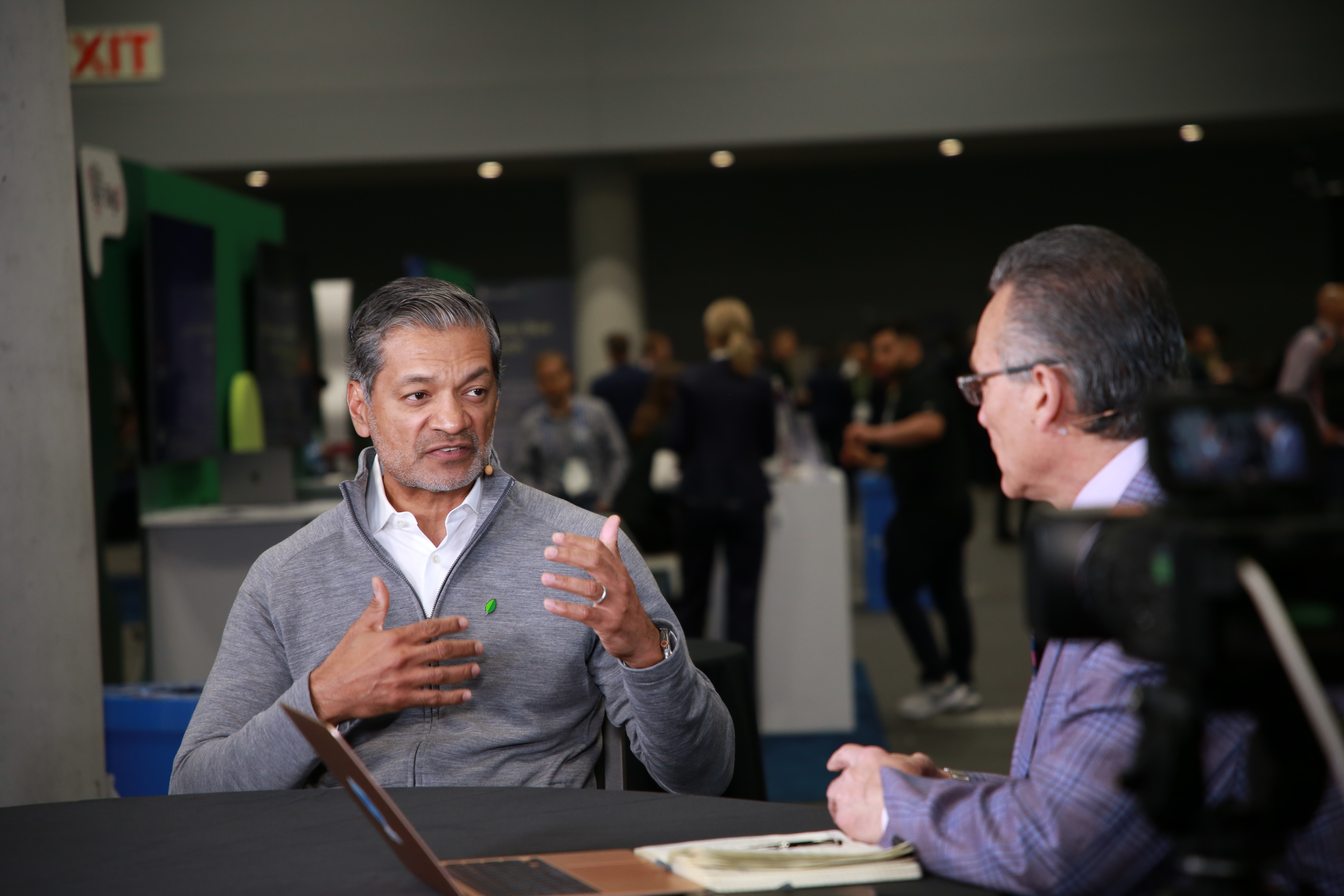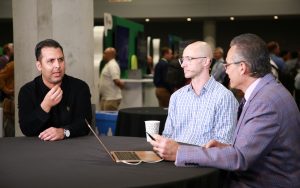 BIG DATA
BIG DATA
 BIG DATA
BIG DATA
 BIG DATA
BIG DATA
Data is the driving force behind the current artificial intelligence surge, with enhanced data capabilities driving AI improvements.
Databases play a crucial role in this, as they must rapidly adapt to meet AI’s demands. MongoDB Inc. aims to lead in enterprise AI by supporting the needs of developer and product teams.

Chief analyst Dave Vellante live for theCUBE’s coverage of the MongoDB.local NYC event.
“MongoDB is a company tracking toward $2 billion with a $28 billion market cap — a high-flyer and very strong growth company in the operational database world,” said Dave Vellante, theCUBE Research founder and chief analyst. “MongoDB is putting so much investment and innovation into the industry, including the MAAP initiative.”
From new, cutting-edge feature drops to clutch product integrations and company strategy, here is a roundup of three things you might have missed during MongoDB.local NYC 2024 (* Disclosure below):
As AI evolves at lightning speed, it is forcing a rethink of business operations and customer interaction. MongoDB’s strategy to drive this transformation focuses squarely on the application layer of the AI stack. Much like the rise of the internet, infrastructure investments in AI underpinnings will largely affect its advancement, according to Dev Ittycheria (pictured), chief executive officer of MongoDB, during an interview with theCUBE.

Unpacking MongoDB’s place in the AI landscape with CEO Dev Ittycheria.
“Right now there’s tons of investors going into the infrastructure layer, but AI has not really transformed my life,” he said. “I can automate certain parts of our business, but it’s not really transformative, but I think it will be. And the way it becomes transformative is these next generation of apps that fundamentally change how we do business, how we drive cost out of the business, how we engage with our customers and how we find new ways to drive growth.”
From a strategy standpoint, MongoDB is walking the talk with the MongoDB AI Applications Program, or MAAP. The recently unveiled initiative’s purpose is to enable faster enterprise AI adoption by equipping companies with handy pre-built integrations, technical expertise and architectures.
“[MAAP] is designed to address three problems,” Ittycheria said. “One, give customers reference architectures to address a certain set of use cases. Two, have a pre-built set of integrations that they can use out of the box to get up and running quickly. And, third, bring some technical expertise so that we can help them go from idea to production as fast as possible — and customers want that.”
MongoDB isn’t a cloud company, and neither does it have any proprietary large language models. This gives the company technical neutrality, allowing it to objectively guide companies to the right set of AI tooling and application infrastructure, Ittycheria added.
“People can say, ‘MongoDB is going to be very thoughtful, they’re independent, they know how to build modern applications, so they can be a real thought partner to me and help me pick the right choice,'” he said. “Then what we found is all the hyperscalers are part of this program. They want to be part of the program because they know how influential we can be.”
Large language models are foundational to every company’s AI aspirations, with several building them in-house. However, with a lot of the hyperscalers standing up powerful open-source LLMs, many companies are better off customizing those to suit their use cases rather than going the proprietary route — which can be expensive and time consuming, according to Ittycheria.
“I believe that these LLMs coming out from these smaller companies will not stand the test of time,” he said. “It takes so much money to build LLMs, and what Facebook announced with Llama 3 last week, the performance they’re delivering, it’s open source. So, why would I build my LLM when I can take Facebook’s LLM and fine-tune it for our own use? It just doesn’t make sense anymore.”
Here’s theCUBE’s complete video interview with Dev Ittycheria:
No solutions company is an island. Customers usually build their tech stack with tools from different shops, meaning that integration and partnerships are inseparable from enterprise tech. With a vastly similar userbase and operating ethos, MongoDB has inked partnerships with Microsoft Corp., Google LLC and Amazon Web Services Inc. for deeper product integrations and seamless cross-platform interplay.
Starting with Microsoft, MongoDB has expanded the operating range of Atlas to include Vector Search for hassle-free data management with AI workloads.

Discussing the MongoDB/Google Cloud partnership with theCUBE.
“The ones that I like the most are our Semantic Kernel and MongoDB Atlas and Vector Search, because when you combine those two for a customer that is using MongoDB Atlas on Azure, then you can have streamlined data management,” said Alvaro Celis, vice president of global ISV commercial solutions at Microsoft, in an interview with theCUBE. “You can have semantic queries that are very effective and can help you feed AI applications.”
With Google Cloud, the big announcements are Gemini Code Assist and MongoDB’s Vertex AI extension. Gemini Code Assist allows developers to query existing code within the Google Cloud Console and get natural language responses. Powered by MongoDB’s extensive data pool, the feature opens up new areas for efficiency, productivity and accuracy for digital companies.
On the other hand, the Vertex AI extension resides within Mongo’s database and brings the capabilities of Google’s Vertex foundational models. For its part, Vertex AI makes data science, machine learning and data engineering workflows available to teams using a common toolset, allowing seamless collaboration and application scalability.
“Vertex is our platform that developers use to create — they take foundational models that we have in our model garden and then tweak and tune them using their data in their intellectual property,” said Stephen Orban, vice president of migrations, ISVs and marketplace at Google Cloud, in an interview with theCUBE. “Now, Mongo’s made an extension available so that we can meet those customers who use and want to continue to prefer Mongo as their data store, to do that as part of their retrieval augmentation.”
With AWS, MongoDB has integrated Atlas Vector Search with Knowledge Bases on Amazon Bedrock, pushing it to general availability. The move is intended to speed up the development of gen AI apps and features that leverage fully managed foundational models.
A notable member of AWS’ recently launched Generative AI Competency Partners program, MongoDB is aligning itself to support important AWS technologies, such as SageMaker and Amazon Q.
“We wanted to make sure our customers were exposed to all of our different partner solutions that integrate to AWS services,” said Mona Chadha, director of category management at AWS, in an interview with theCUBE. “In turn, those partners can help customers with integrations to their applications.”
Here’s theCUBE’s complete video interview with Alan Chhabra and Stephen Orban:
MongoDB has always made it clear that developers are its primary target demographic. With an emphasis on seamless operation, collaboration and functionality, the platform has won over the team from Arc XP, a division of The Washington Post.

Discussing MongoDB’s workflow use cases with Arc XP’s Joey Marburger and Joe Croney from The Washington Post.
Operating in a saturated content management space, Arc XP differentiates itself by catering to diverse media workflows and staying abreast with emerging digital publishing trends. MongoDB and its wide array of developer features has been instrumental to achieving that, according to Joe Croney, vice president of technology and product development at The Washington Post.
“Part of the story for us is a focus on developer experience,” Croney said in a recent theCUBE interview. “It’s one of the reasons that my team loves using MongoDB, is all the services MongoDB has for developers. The same is true for Arc XP. We have a robust set of SaaS tools for developers to access through our APIs and really embed workflows around high volume content creation for their editorial teams.”
Here’s theCUBE’s complete video interview with Joe Croney and Joey Marburger:
Watch theCUBE’s full coverage of the MongoDB.local NYC event here:
(* Disclosure: TheCUBE is a paid media partner for the MongoDB.local NYC event. Neither MongoDB Inc., the sponsor of theCUBE’s event coverage, nor other sponsors have editorial control over content on theCUBE or SiliconANGLE.)
Support our mission to keep content open and free by engaging with theCUBE community. Join theCUBE’s Alumni Trust Network, where technology leaders connect, share intelligence and create opportunities.
Founded by tech visionaries John Furrier and Dave Vellante, SiliconANGLE Media has built a dynamic ecosystem of industry-leading digital media brands that reach 15+ million elite tech professionals. Our new proprietary theCUBE AI Video Cloud is breaking ground in audience interaction, leveraging theCUBEai.com neural network to help technology companies make data-driven decisions and stay at the forefront of industry conversations.